In the 1990 Dolph Lungren movie I Come in Peace (a.k.a. Dark Angel), a mysterious alien with a platinum blonde mullet happens upon a high-stakes drug deal gone bad. He says, “I come in peace.”
In “Vaulting Ambitions,” the most recent episode of Star Trek: Discovery, Michelle Yeoh with a Goatee (a.k.a. Terran Emperor Georgiou), hears that Michael Burnham is from an alternate universe. She pledges to help Michael return in exchange for the engine schematics for the Discovery’s spore drive. She says that, like Captain Georgiou of the Federation, she must be “a woman of honor.”
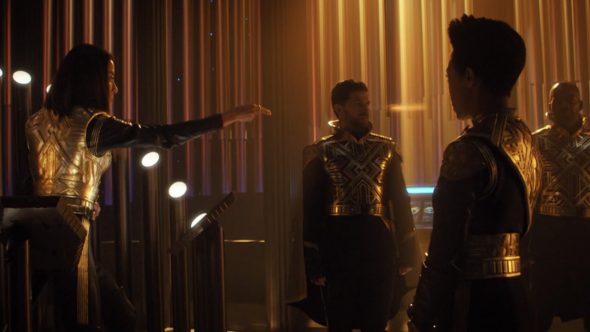
These scenes have two things in common:
- The alien and the Emperor both murder everybody in the room by shooting a flying CD that homes in on henchmen and natural-20s them into gory B-movie death.
- They are both lying about their quality of character.
Well, Georgious doesn’t kill everybody (The Blood Mop Guy becomes governor of Andor! Bet he’ll clean that place up!), but in the Mirror Universe, real and unreal mean the same thing, and shit just got it.
So I can, so I can
Bottom line: it’s showtime on DISCO. We know who all the main characters are, finally, which means everybody can do in-character things onscreen.
- Leather-Jacket Lorca goes rogue and breaks out of space jail!
- Vulcan-Raised Michael tries to use shared history to cross cultural barriers.
- Stamets makes out with Hugh’s ghost while grooving to opera in the fungus dimension!
- Tilly offers journeyman technobabble and skin-tone compliments.
- The star-crossed Klingons howl and thrash and stick things in each other in grand gestures of love, pride and loyalty!
- And acting captain Saru does what he does best: delegate.
“Vaulting Ambitions” may not be “action-packed,” but it’s “packed with actions.” It also clocked in as the shortest episode of any live-action Star Trek series to date, at a slim 37 minutes. A brisk enough experience that I put away my notebook in the second half and just watched.
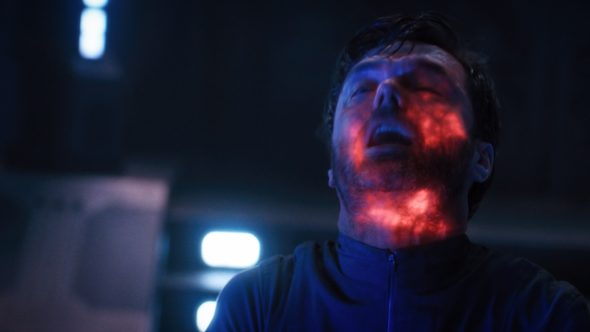
“The Patriots are in the Super Bowl AGAIN??”
Though when your notes say:
SCENE
“YEAAAAARRGH!”
SCENE
“YEAAAAARRGH!” transition
SCENE
they can be just as much a joy on their own as they are useful.
Keep track of the vision in my eyes
We did get some pretty good substance with the style, though. While she wasn’t murdering her entourage this week, Emperor Georgiou explained the metaphysical principle defining the Mirror Universe in Discovery: humans in the Mirror Universe can’t see light. That is, they are sensitive to “normal” brightness to the point of it causing them pain.
But it’s not just eyeballs that abide by the principle. While space in the regular universe is bathed in starlight, in the Mirror Universe it is moody and nebulous. And it’s a symmetrical principle, an ontological dualism around the relative openness to light and darkness, rather than just a uniform shift into shadow.
Classic Star Trek Mirror Universe episodes lean hard on “Evil Twins.” The Starfleet characters confront campy evil “opposite” versions of themselves, and in doing so, reaffirm who they really are. Discovery seems to be playing more with a “Mirror Ambience.” By shifting the light, the Starfleet characters come to see themselves differently, challenging where they stand in the balance of light and dark.
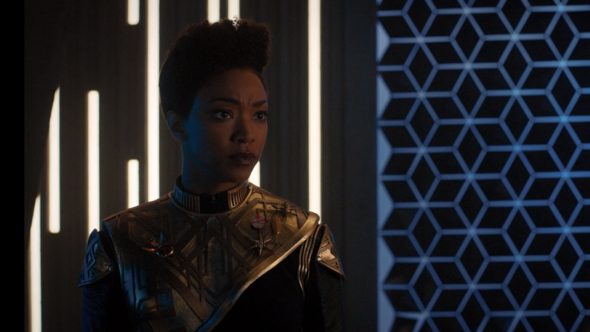
Crossing the threshold from one universe to the other doesn’t increase the rigidity of who people are, it threatens to change them. It’s not just that there’s a Captain Lorca and a Leather-Jacket Lorca — there’s a Lorca who changes clothes depending on what universe he’s in. There’s not just “Tilly” here and “Killy” there — now Tilly wears her long blonde wig in every scene.
When we learn in this episode that Emperor Georgiou, not Sarek, was Michael Burnham’s adoptive mother in the Mirror Universe, it’s not so much a reversal to how things were as the change from a 20/80 arrangement to an 80/20 one.
In the Mirror Universe, it’s Georgiou who raises Michael, and Sarek who sees the potential in her and gives her authority and legitimacy. In the regular universe, it’s just the other way around. It’s all modes of parenting.
This is the third episode the Discovery has been in the Mirror Universe, and Stamets is the only characters to have actually “met” himself yet. For everybody else, the only different versions of themselves in the Mirror Universe are the ones they are told about and the ones they live.
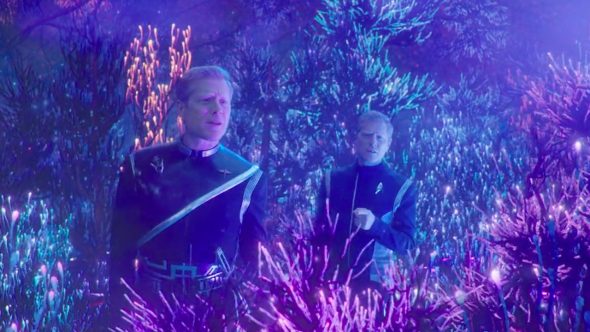
Well, Stamets and the other guy “stuck outside himself” — Ash/Voq.
Don’t switch the blade on the guy in shades
In the Mirror Universe, while the humans are darker, the Klingons are lighter. Voq, the Albino Klingon (he of the symbolic light skin) is the living steward and embodiment of the fire of Kahless. He’s the “light” of the potential unity of the Klingon Empire. And yet, looking at his story to this point, his inability to “see light” seems more limited in the regular universe than the Mirror one.
In the regular universe, Voq is “the Torchbearer” a solitary light in a place of darkness: the Klingon Ship of the Dead, caked in magnetized coffins. In the Mirror Universe, Voq is “the Fire Wolf,” not a lone light but a pack leader, on a bright and sunny world surrounded by friends and “listening posts.”
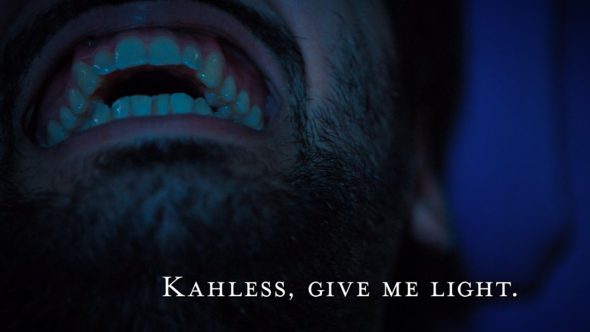
And in each universe, Michael sets a blaze around Voq. In the Mirror Universe, Voq burns with sacrifice for the people he cares for and is responsible for. In the regular universe, he burns with hatred and destruction for his enemies.
The season continues to build a meta-narrative of ontological dualism around Michael and Voq, which has spiraled out into a dozen pairs of opposites in tension between cooperation and mutual destruction: logic and emotion, unity and war, duty and mutiny, human and Klingon, born self and created self, parent and child, lover and victim, independence and togetherness. Yes, even their dark and light skins build on the theme.
Thanks to this thematic explanation of “photosensitivity” from Emperor Georgiou, the season rotates even more around the dance that Michael and Ash/Voq share in the midst of the time loop in “Magic to Make the Sanest Man Go Mad” — they aren’t set against the backdrop of the Federation/Klingon war, they are the Federation/Klingon war. And the Federation/Klingon peace.
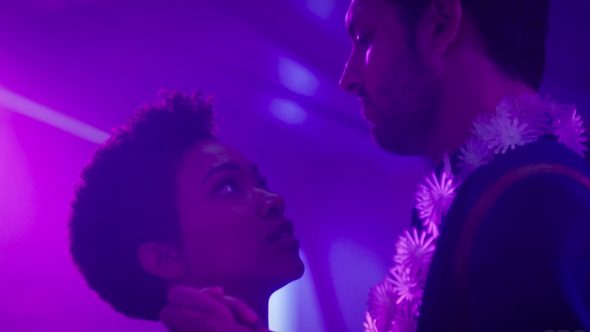
Note the allusion to the mycelial network around his neck in the purple light.
We know this war and peace will balance on a knife in The Original Series and the peace will endure and strengthen, even as it faces new risks, into The Undiscovered Country and The Next Generation. It’s not a war about beginning, violence and conclusion, but about Yin and Yang. The Federation and the Klingon Empire are in eternal opposition to each other. Each can recognize bit of themselves in the other, but also a whole lot of the other way.
All this reaches some manner of consummation for Voq in “Vaulting Ambitions.” L’Rell performs finger-laser-knife brain surgery on Ash/Voq, which culminates in her howling upward in a clear example of the well-established Klingon death ritual. The specific consequences of it for Ash/Voq remain to be seen.
Of course, Klingon religious scholars would tell you that the death ritual is not about the ending of a Klingon warrior, but about their approach to Sto-vo-kor, the Klingon Valhalla, an afterlife of eternal battle. It’s a new beginning.
The meaning of the howl of the death ritual is “Beware, a Klingon warrior is about to arrive.”
Don’t masquerade with the guy in shades
Oh yeah, Lorca was Mirror Universe Lorca the whole time, which was a reasonable guess at any point after he showed up. It turns out he didn’t act like a Starfleet captain that whole time because he wasn’t one.
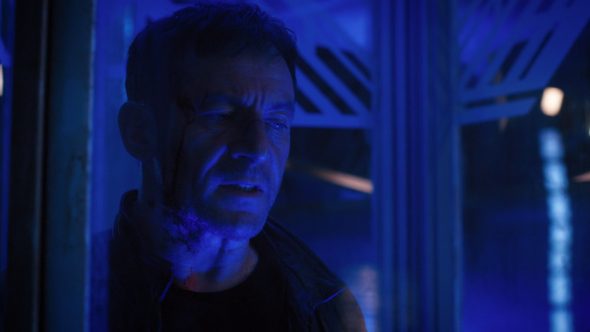
It was obvious to hardcore fans who read message boards three episodes back, obvious to somewhat less hardcore fans two episodes back, obvious to more casual fans last episode, and finally confirmed this episode because this is a show that likes to telegraph what it’s going to do well in advance so that people can watch it while making dinner without missing anything.
I like finally having this out in the open. Even though this Trek show shown characters not as islands of stability in a stormy universe, but as swept up by the currents, it still feels good to know where everybody is treading water, more or less.
I just hope, now that he’s gone rogue for real, that Lorca has enough practice grabbing dudes by their lapels and asking them where the device is.
You got it made with the guy in shades
Finally, we can’t talk about this episode without talking about the stirring reunion between Paul Stamets and Hugh Culber. I refer to the pair as “Hugh and Stamets” for euphony’s sake, even if it’s one first name and one last. But now that seems fitting, as the two stand on opposite sides of their own metaphysical duality: Stamets is alive, while Hugh is dead.
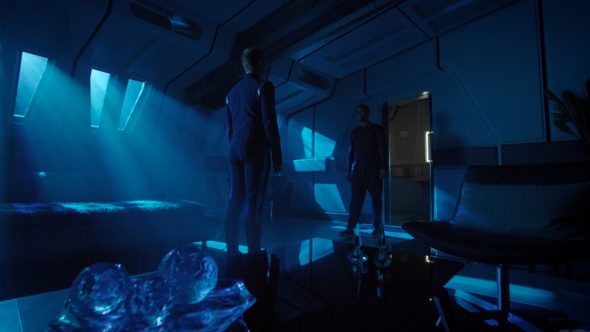
The two meet in the rule-bending suspended space of the mycelial network, where Stamets’s regular self and mirror self are both caught on an edge of death — though for Mirror Universe Stamets it’s death and working, and for regular Stamets it’s death and loving.
And their meeting is properly beautiful and operatic, taking us back to the moments of tender couples toothbrushing in matching Starfleet PJs, but returns us to “The Woods,” where, of course, there is beauty, but also a monster.
It introduces us to a new Big Bad for the season, a corruption threatening to destroy the mycelial network and perhaps life in the universe as we know it. With this blight on the other side of the door, the season might not turn on a war we already know the result of, but on something else.
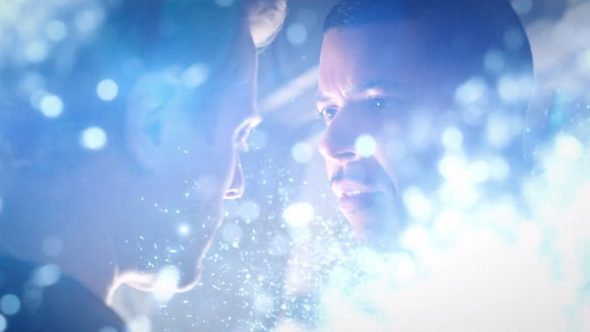
The light incrementally brightens through this whole sequence.
And to close, I’ll say it also reminds me, in its threat and promise, of Longfellow’s introduction to Evangeline.
This is the forest primeval. The murmuring pines and the hemlocks,
Bearded with moss, and in garments green, indistinct in the twilight,
Stand like Druids of eld, with voices sad and prophetic,
Stand like harpers hoar, with beards that rest on their bosoms.
Loud from its rocky caverns, the deep-voiced neighboring ocean
Speaks, and in accents disconsolate answers the wail of the forest.This is the forest primeval; but where are the hearts that beneath it
Leaped like the roe, when he hears in the woodland the voice of the huntsman?
Where is the thatch-roofed village, the home of Acadian farmers,—
Men whose lives glided on like rivers that water the woodlands,
Darkened by shadows of earth, but reflecting an image of heaven?
Waste are those pleasant farms, and the farmers forever departed!
Scattered like dust and leaves, when the mighty blasts of October
Seize them, and whirl them aloft, and sprinkle them far o’er the ocean.
Naught but tradition remains of the beautiful village of Grand-Pré.Ye who believe in affection that hopes, and endures, and is patient,
Ye who believe in the beauty and strength of woman’s devotion,
List to the mournful tradition, still sung by the pines of the forest;
List to a Tale of Love in Acadie, home of the happy.
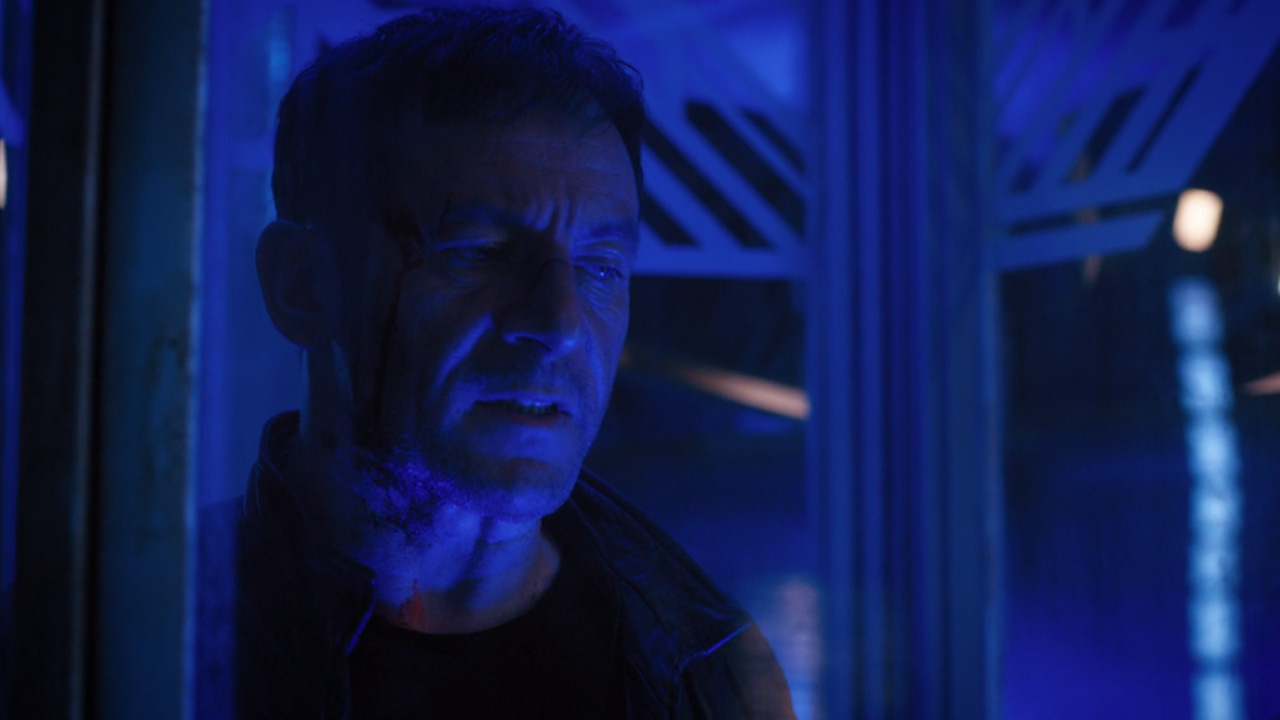
Let’s have it out with this whole Mirror Universe business
To state the obvious: Star Trek’s Mirror Universe asks a lot from the audience in terms of suspension of disbelief. We are really meant to believe that, in a completely parallel dimension, that entire starships and crew compositions are replicated, and that, oh, I don’t know, Tilly’s great great great grandparents weren’t offed by marauding Terran Empire hordes centuries ago?
The answer to that question is, yes, we are meant to believe that. Or at least we are meant to accept it as the premise and then move on with our lives.
DISCO seems to be going out of its way to play up this whole “destiny” business and that all of these people are drawn together across universes by fate. This may be par for the course for Star Trek Mirror Universe stories, but taken on its own, and presented for several episodes in a row, it makes Star Trek feel more like…science fantasy rather than science fiction. Like there’s some invisible force binding living creatures together, across universes and between life and death.
I’m still on board with all of this but am hyper conscious of the extra suspension of disbelief I’m being asked for.
Yeah, in part I think this is ameliorated when the shows only spend a single episode or a pair of episodes in the Mirror Universe, because then it’s more similar to a random planet that has apparently evolved exactly the same as all the other planets, except in this planet they don’t think people with short hair should learn how to read, or whatever other contrivance is the single fact about this entire world that defines what it is.
For me this goes back to the fundamental difference, at least as far as I sussed out on The Orville Petecast, between Discovery and Classic Trek – which is that in Trek, the intentions of the characters stay intact, and the environment changes. Whereas in Discovery, the characters are symbolically related to wherever they are and they change along with their environment in a sort of microcosm/macrocosm.
The difference here I think is in groundedness (which I tend to define as a conceivable relationship between emotional reactions and circumstances) – if a character is a single fixed point, then weird, weird shit can happen around them and it can still feel grounded. If the situation is solid and the character is fluid and blows like the wind (like, say, Zach Galifinakis’s character in the Hangover), then it can also feel grounded.
But if both the situation and the character are blowing all over the place, it’s hard for it to still stay grounded.
_Star Trek: Enterprise_ did a really cool thing with this, when they actually redid the James Cromwell first contact scene from First Contact, but in the Mirror Universe (I won’t spoil what it is – just boot up Netflix and watch the cold open, it’s Season 4, “Through a Mirror Darkly, Part I”) – and that to me _grounded_ their concept of the Mirror Universe – it sets a clear expectation for when and how things are diverging from what we know.
Discovery sometimes feels grounded (like it feels grounded when the only difference is that Michelle Yeoh is an armored potentate, or like with Stamets and Hugh), but as a whole, I’m not sure the whole thing is holding it together. This episode held together better than the last, I think. We’ll see how the next one goes.